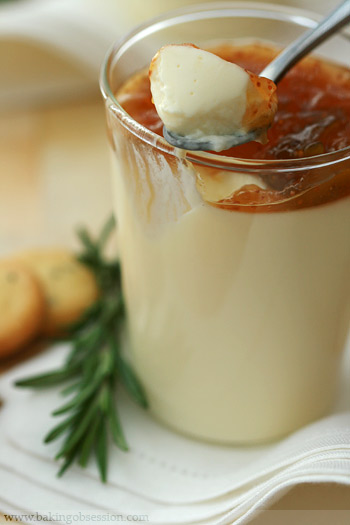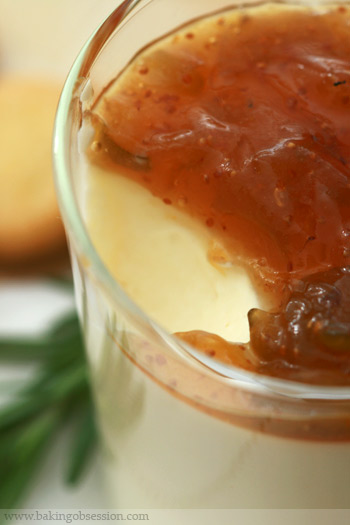
In the large family of creamy desserts the panna cotta is the easiest and fastest one to prepare. It simply sets with gelatin; but what really matters is the quantity of the gelatin used. Too much of the last and the panna cotta gets unpleasantly rubbery. I think the best textured panna cotta is served from a bowl (or glass, or ramekin) but not proudly presented unmolded on a plate. Less formal presentation requires less amount of gelatin ensuring better mouthfeel. Flavor-wise, I love the yogurt or buttermilk panna cotta best for its tanginess. And I simply adore it for its calorie-moderation.

Makes 6 servings of panna cotta and about 5 ½ dozens of tiny cookies
For the rosemary cornmeal cookies:
- 1 cup all-purpose flour
- ½ cup fine stone-ground cornmeal
- ¼ tsp salt
- ½ cup fine granulated sugar
- Zest of 1 large lemon
- 1 stick (1/4-lb; 113g) unsalted butter, softened
- 2 large egg yolks
- ½ tsp pure vanilla extract
- 1 tbsp finely chopped fresh rosemary
For the panna cotta:
- 2 tbsp Limoncello liqueur
- 2 tsp gelatin
- 1 cup whipping cream
- ½ cup fine granulated sugar
- 1/8 tsp (pinch) salt
- 2 cups low-fat or no-fat unsweetened yogurt
- 1 tsp pure vanilla extract
- ¾ cup good quality fig jam (I love St. Dalfour)
- Zest of ½ lemon
- 1 tbsp Limoncello
Make the cookies:
Center an oven rack and preheat the oven to 350F. Line cookie sheets with parchment paper or silicone mats.
In a small bowl, whisk together the all-purpose flour, cornmeal, and salt to combine. Set aside.
In another small bowl combine the sugar and lemon zest. Rub with your fingertips to release the lemon oil. Set aside for a moment.
In a medium bowl, using an electric mixer, beat the butter until fluffy. Gradually beat in the sugar and continue mixing until light and well combined. Beat in the egg yolks, one at a time, then beat in the vanilla and rosemary. Add the dry ingredients and mix on the low speed just until the dough forms; you might finish mixing with your hands or a wooden spoon.
Measure out one-teaspoon portions of the dough and roll into small balls. Place the balls onto the prepared baking sheet about 1-inch apart. Flatten the balls to the ¼-inch thickness with your hand or a bottom of a small glass. Refrigerate for 20 minutes before baking. Bake the cookies, in batches, for 12 to 14 minutes, until lightly golden. Cool on the baking sheet on a rack for 10 minutes. Then transfer to the cooling rack to cool completely. Store the cookies in an air-tight container at room temperature up to a week.

Make the panna cotta:
Pour 2 tbsp of the Limoncello into a small bowl and sprinkle the gelatin over. Let soften for a couple of minutes.
Meanwhile, in a small saucepan, combine the whipping cream, sugar, and salt. Heat over medium heat, stirring, until the sugar is dissolved and the cream is hot. Remove from the heat and whisk in the softened gelatin; whisk until the gelatin dissolves. Set aside.
Place the yogurt in a large liquid-measuring cup (a spout will make the later pouring easy). Add the vanilla extract and whisk to combine and lighten the yogurt. Gradually, whisk in the hot cream-gelatin mixture. Divide the mixture equally between six 8-oz bowls, glasses or ramekins. Once cooled, cover with plastic wrap and refrigerate overnight.
Right before serving or close to the serving time, combine the fig jam, lemon zest, and Limoncello in a small microwave-safe bowl. Warm the mixture gently, so it’s barely warm to the touch. The jam should be spreadable but not hot; otherwise, it will melt the panna cotta. Spoon 2 tbsp of the fig jam over the top of each panna cotta and gently spread the jam. Serve right away or refrigerate until needed.



July 12, 2010 at 6:29 pm
I haven’t tried or heard of panna cotta ’til I ran into this recipe the other day. Absolutely delicious! I substituted the fig jam with peach jam (same brand as suggested in the recipe) and topped with fresh peaches.
It is such a light summery dessert. I’m chilling another batch today. Can’t wait ’til they’re done!
June 3, 2009 at 10:44 am
I was referred to this recipe from 30 A Week. Looks amazing. Will tag fir future use!
May 16, 2009 at 1:36 am
MMMMM….I love this beautifully combination!! Waw!! This is an excellent dessert: great for a dinner party that is coming up,….
April 7, 2009 at 6:32 am
Lauren B, sure you can. The dessert is very creamy even with a low-fat yogurt.
April 7, 2009 at 12:16 am
Can I use regular organic whole milk yogurt?
What about FAGE total greek yogurt? Would that make it too thick? I love the idea of a nourishing, creamy yogurt dessert. Thank you for any tips!
February 27, 2009 at 10:41 pm
This looks delicious, but as I don’t use gelatin I have a problem making pannacotta. I have experimented with agar but am yet to get the perfect proportion. I am working on it though.:)
Love the little cookies.
February 24, 2009 at 12:38 am
Tremendous thank you to everyone who left a comment!
February 23, 2009 at 4:44 pm
I think I’m in love with the rosemary cookies. Well done.
February 23, 2009 at 8:24 am
The rosemary cornmeal cookies look like a perfect pairing with your divine lowfat version of panna cotta. Such a pretty presentation! This is a panna cotta that I will definitely be trying!
February 22, 2009 at 5:36 pm
I am so gonna try ur healthy panna cotta…but first m off to making those cookies :)
February 21, 2009 at 9:16 pm
This looks and sounds so delicious!! =)
February 21, 2009 at 7:07 pm
I have been meaning to make Panna Cotta. This looks WONDERFUL
February 21, 2009 at 6:37 pm
you are so right about the gelatin! i was experimenting today with yogurt panna cotta and while it looked beautiful, i definitely used way too much gelatin and it didn’t have the wonderful texture that i love. i’ll take some tips from your recipe, which looks great.
February 21, 2009 at 3:26 pm
although I m not a fan of panna cotta this looks delicious and so creamy :) I love the cornmeal cookies. So interesting! I d love to try these :)
February 21, 2009 at 8:26 am
This looks lovely! I also love the flavors you infused into it. :)
February 21, 2009 at 7:10 am
Very elegant panna cotta and cookies. The cornmeal cookies sound so tasty; rosemary offers such a nice flavor and aroma to sweets.
February 21, 2009 at 6:13 am
ah, calorie moderation. always a good thing. :) this is a special and stunning treat, vera. bravo, and bravo. :)
February 20, 2009 at 10:15 pm
Pigpigscorner, thank you very much! They were pretty good together :)
Jamala, спасибо! Заменять сливки на сметану я бы не советовала. Whipping cream – это 35% жирности сливки; если их невозможно найти, то можно взять сливки любой другой (меньшей) жирности, и при этом использовать нормальной жирности йогурт (необезжиреный). Кстати, часть йогурта можно смело заменить на сметану (несладкую). Я использовала очень кислый обезжиреный йогурт, и на мой вкус, сахара было вполне достаточно.
Jacque, thank you! And you are very welcome :)
Deeba, thank you! I’ll check you panna cotta, for sure :)
Y, thank you very much! I’m so glad you are with me :)
Jen, have no fear! There’s nothing easier :)
Aran, thank you!
Elyse, thank you very much! Gelatin can be an evil thing if it’s used generously :)
Rosa, thank you!
Maria, thank you! I loved it too :)
Christy, thank you very much! But I have to admit the plated version always looks so deceivingly appealing :)
Kate, thank you! Although, I’ll have to disappoint you – the cookies are quite sweet, but they go well with tangy panna cotta. :)
February 20, 2009 at 5:03 pm
Your photos are stunning. And I completely agree about the stand-alone panna cotta’s. Ick! And the cookies sound wonderful – the idea of something savory to go with the sweet is very appealing.
Thanks!
Kate
February 20, 2009 at 4:35 pm
Vera I agree with your opinion on panna cottas; I’m always wary of those which stand tall and proud on the plate. I really love your setting in the first photo–stunning!
February 20, 2009 at 11:32 am
deeliccccious ! I love the cookies !
February 20, 2009 at 10:16 am
Love this dessert!! Cornmeal cookies sound divine!
February 20, 2009 at 8:38 am
Splendid and great pairing! That’s an exquisite dessert!
Cheers,
Rosa
February 20, 2009 at 7:35 am
Wow! Your panna cotta and cookies look delicious! I’ve had some bad experiences in the past with panna cotta, but I think you’re right: it must have been because there was too much gelatin. I’m going to take your advice and limit the gelatin and make this in bowls and cups. And those rosemary cornmeal cookies, what precious gems! I have a hankering to try those right now!
February 20, 2009 at 7:20 am
i also made yogurt panna cotta recently and i love the bit of acidity in it. gorgeous!
February 20, 2009 at 6:26 am
I keep reading about panna cotta but have never tried it… I think it’s a bit too cold here now, but once the weather warms up I will have to get over my fear of gelatin and make it. This yogurt version looks especially good.
February 20, 2009 at 5:53 am
Those cookies look wonderful! I’m totally with you about buttermilk and yogurt pannacottas – they’re my favourites too! :)
February 20, 2009 at 5:31 am
Just gorgeous Vera. Have to agree about the amount of gelatin & that panna cotta is better from the glass/bowl rather than unmoulded. the one I made last week refused to leave the mould, but was delicious! Yours is gorgeous & the low-fat yogurt option is a winner in my favourite dessert of all time!
February 20, 2009 at 5:10 am
Mmmm, that looks wonderfully light and delicious! Thanks for the info on the quantity of gelatin. I’d never thought of it that way.
February 20, 2009 at 2:34 am
Выглядит так по полдничному аппетитно! Особенно меня заинтересовало печенье :)) Вера, как вы думаете, можно ли взять сладкую сметану вместо сливок? Или все-таки с йогуртом будет чересчур кисло? Спасибо!
February 20, 2009 at 1:10 am
Lots of wonderful flavours and texture going on therer. Must be deicious together!